Archive for May, 2018
12-year-old UT student creates faster, cheaper way to make pharmaceutical drugs, agricultural pesticides
Thursday, May 31st, 2018Like many 12-year-olds, Daniel Liu enjoys reading books and wears t-shirts covered in cartoon characters.
Unlike most boys and girls his age, Liu has been honored at the White House for his science achievements and is now a published scientific researcher at The University of Toledo.

Daniel Liu
The Ottawa Hills High School student has been taking classes at UT for more than a year through Ohio’s College Credit Plus program.
Liu is one of three members of a UT green chemistry lab team that created a chemical reaction that results in a faster, cheaper, more environmentally friendly way to make pharmaceutical drugs and agrochemicals, such as pesticides and herbicides.
The team’s research, which was recently published in the Journal of the American Chemical Society, shows how carbon dioxide in the form of dry ice is used to break up carbon-hydrogen bonds, reactions known as C-H activation.
“We showed that we could run this reaction with many different starting materials and produce very diverse products,” said Liu, a co-author on the paper.
“When you take an unreactive carbon-hydrogen bond, which is found in most organic compounds, and break it to convert it into a new type of bond, you make new molecules more quickly and more sustainably, especially in pharmaceutical and agrochemical molecules,” said Dr. Michael Young, assistant professor in the UT Department of Chemistry and Biochemistry.
That means, much like Liu’s sky-rocketing academic journey, you skip grades or steps in the process, reducing the time and resources it takes to achieve results.
“This chemical reaction cuts up to five steps out of a process that normally takes six or seven,” Liu said. “C-H activation also improves overall synthetic efficiency. We found a way to potentially help patients, farmers and the environment when it comes to how medicine and pesticides are made.”
Dr. Mohit Kapoor, UT post-doctoral researcher in medicinal and sustainable chemistry, said Liu has demonstrated an incredible ability to learn and discover at the collegiate level.
“I now see him as a co-worker in my lab. He is a genius and a prodigy,” Kapoor said. “But I remember in the beginning thinking, ‘How could he handle all these things?’ He has proven that he has the knowledge. He can do the work properly and learns quickly.”
“While this is highly unusual, Daniel has unusual talent and great support from his parents,” Young said. “He has already taken most of the junior-level course work in the chemistry program. While he doesn’t have the emotional maturity or physical stature of an older student, he is intellectually advanced compared to his peers.”
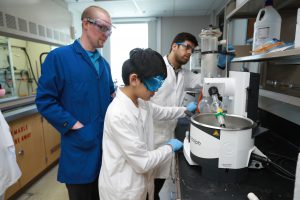 Young, Kapoor and Liu are the three authors of the research paper. The scientists say Liu was involved in every step of the project, investing more than 400 hours of work.
Young, Kapoor and Liu are the three authors of the research paper. The scientists say Liu was involved in every step of the project, investing more than 400 hours of work.
“Daniel made many of the starting materials for the reactions and also performed many of the key reactions. He also remade the compounds to validate that we could do this, help make enough of them to characterize them, and prove they were what we said they were,” Young said. “Plus, he helped us craft the manuscript. He went through and made suggestions on how to present our work.”
UT has filed a provisional patent on the work and the team is looking to market to pharmaceutical companies that make generic drugs.
“We’re excited about the potential to commercialize this because it is much cheaper and more easily recyclable,” Young said. “This really could be a benefit to the synthetic community.”
Liu’s passion lies in developing new pharmaceutical drugs to help people fight different diseases.
“I feel like this is the start of a career and hopefully I can do more of this research in the future,” Liu said. “I’m starting work on a couple of these projects by myself. I simply want to help people.”
Liu started high school at the age of 10.
In 2016 Liu visited the White House and met President Barack Obama after winning the national “You Be the Chemist” challenge – defeating 30,000 other students. He was the youngest ever to win the Chemical Education Foundation’s competition.
Recently, he received high honors in the National Chemistry Olympiad.
Liu also is assistant principal cellist in the University orchestra. It’s one way he has become involved in UT’s vibrant, diverse campus.
“I had an adjustment period, but this is normal to me now,” Liu said. “I feel at home here and supported in my studies. I’m trying to take advantage of all that UT has to offer so I can keep learning and growing. I want to go to graduate school. I’m also considering medical school. I want to do more stuff that changes the world and helps people.”
UT law scholar wins Fulbright grant to research women’s housing advocacy in Ecuador
Tuesday, May 29th, 2018A law scholar at The University of Toledo was awarded a prestigious Fulbright grant to conduct research on women’s housing advocacy in South America.
Shelley Cavalieri, UT associate professor of law, will spend the 2018-19 academic year in Quito, the capital of Ecuador, teaching law courses in gender theory, housing and health, and clinical legal education at the Universidad de San Francisco de Quito.
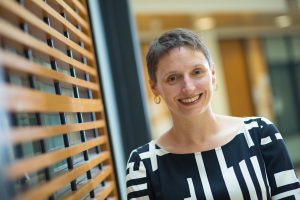
Shelley Cavalieri
Gender and housing are crucial issues in Ecuador due to an extreme gender pay gap, rapid urbanization, and the inadequacy of housing. Cavalieri proposes using socio-legal methods to conduct her research — working closely with citizen activists, nongovernmental organizations, local academic experts and government officials.
“The housing issues that are central to my Fulbright proposal are rooted in the same questions of citizen engagement in and government response to the problems of urban life that form my research at home,” Cavalieri said. “My Toledo experiences will shape my research in Quito, and my time in Ecuador will enrich my work in Toledo.”
Cavalieri teaches property law at UT. She is a leading expert on human trafficking, land reform and land banking. Her research focuses on feminist legal theory and economic, social and cultural rights.
“Being selected for a Fulbright is one of the highest honors that an academic can achieve,” said D. Benjamin Barros, dean of the UT College of Law. “During her Fulbright, Professor Cavalieri will be doing important research on the impact of women’s advocacy in improving housing access and quality. She also will be a wonderful ambassador for the UT College of Law and the University.”
Recipients of Fulbright awards are selected on the basis of academic and professional achievement, as well as record of service and leadership potential in their respective fields.
The Fulbright Scholar Program offers grants to American faculty, administrators and professionals to teach and conduct research abroad. The program is sponsored by the United States Department of State’s Bureau of Educational and Cultural Affairs and administered by the Center for International Studies and Programs at The University of Toledo.
Cavalieri is a graduate of the University of Virginia, where she received a bachelor of arts degree in bioethics, and the University of California at Berkeley, where she received a law degree.
Cavalieri is from Columbus. She grew up in Westerville, Ohio. She lives in Toledo with her family.
UT scholar to host news conference about words used to describe alleged victim of child sex trafficking
Wednesday, May 23rd, 2018In response to recent media reports about a case involving a former Toledo police officer, The University of Toledo Human Trafficking and Social Justice Institute is hosting a news conference at noon Friday, May 25 at the Kent Branch Library, located at 3101 Collingwood Blvd.
Dr. Celia Williamson, a UT professor of social work who defends the rights of women and girls on a local, national and international level, organized the event along with the Lucas County Human Trafficking Coalition to discuss the importance of words and to educate the public on child sex trafficking.
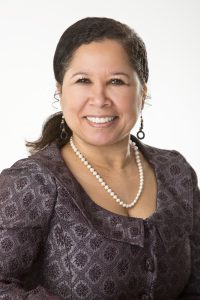
Dr. Celia Williamson
“Language is a powerful way of denigrating oppressed populations who society views as less valuable,” said Williamson, who is the director of the UT Human Trafficking and Social Justice Institute. “When an alleged victim is 14 years old, she is not a ‘child prostitute’ or ‘under-aged prostitute.’ Child sex trafficking is modern day slavery.”
Williamson wants to decrease the stigma associated with alleged child sex trafficking victims and rally the community to support them.
“We want to assure child victims who may be out in our community that we want them to come forward and get help,” Williamson said. “The community also needs to know the proper language to use when discussing the topic of commercial sex with a child.”
UT and BGSU to grow independent nursing education programs
Tuesday, May 22nd, 2018In order to meet the demand for more nurses in the region and across the country, The University of Toledo and Bowling Green State University will pursue independent nursing programs to educate additional health care providers.
UT and BGSU currently partner in a joint nursing consortium. Moving forward with independent programs will provide opportunities for both universities to focus on separate strategies to educate and grow the supply of nurses, which is critical to meeting the future healthcare needs of the region.
All current BGSU nursing students and new students beginning their studies in Fall 2018 will continue with the consortium program through graduation and will not be impacted by the change.
Under the existing agreement, about 50 BGSU pre-nursing students annually go on to complete their required nursing coursework and clinicals through the UT College of Nursing after two years of pre-nursing studies at BGSU. While the students take their classes at UT during their junior and senior years, they remain BGSU students and are awarded their bachelor’s degree by BGSU.
“Health care is a rapidly changing industry and universities need to continue to adapt to the changing environment in order to provide the best education for future health care providers,” UT President Sharon L. Gaber said. “The nursing profession is more critical than ever and this new organizational structure will allow both UT and BGSU to grow our programs to better meet the need for more high-quality nurses in Ohio and beyond.”
The demand for nurses in Ohio and across the nation far exceeds the current supply. According to the Bureau of Labor Statistics, registered nursing is among the top occupations in terms of job growth through 2024. The nursing workforce is expected to grow by 16 percent to 3.2 million by 2024 with more than one million job openings for nurses due to growth and replacements.
“We agree that the time is right to pursue new partnerships,” BGSU President Rodney Rogers said. “We recognize that there is growing demand for nurses throughout northwest Ohio. This provides both universities the opportunity to grow their respective programs.”
UT and BGSU continue to be strong partners. Last year the universities announced a foreign language course exchange program. The universities also are partners in the Building Ohio’s Sustainable Energy Future (BOSEF) initiative, a joint program that encourages students to pursue research careers in renewable energy and sustainable environmental practices.
Additionally, UT and BGSU are collaborating on the Regionally Aligned Priorities in Delivering Skills (RAPIDS) program, which allows universities to purchase state-of-the-art equipment for use in learning laboratories specific to regional workforce needs and then share these resources with other colleges and universities to help more students get a quality education more affordably. The universities also are focusing efforts on addressing the opioid crisis and Lake Erie water quality concerns.
UT medicinal chemist awarded $2 million to study Alzheimer’s, drug addiction
Tuesday, May 22nd, 2018The National Institutes of Health awarded two grants totaling more than $2 million to a synthetic and bioanalytical organic chemist at The University of Toledo whose research is primarily focused on Alzheimer’s treatment.
The National Institute on Aging awarded Dr. Isaac Schiefer, assistant professor in the Department of Medicinal and Biological Chemistry in the UT College of Pharmacy and Pharmaceutical Sciences, $1.9 million over five years to continue developing a drug to treat Alzheimer’s disease, and the National Institute on Drug Abuse awarded him $153,500 over two years to study drug targets to addiction centers in the brain.
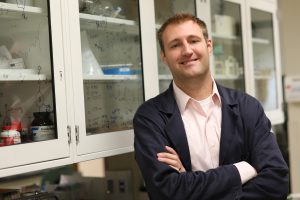
Dr. Isaac Schiefer
At 33 years old, Schiefer is among the youngest investigators to receive this level of research support across all NIH institutes, according to NIH records.
“I am proud that my lab’s work in drug discovery and design at the University is garnering so much support,” Schiefer said. “Brain disease is heartbreaking, no matter if you’re suffering from Alzheimer’s or drug addiction. I hope to create new ways to understand how the brain works and help families find better treatment options for their loved ones.”
Schiefer developed a prototype molecule that improves memory in mice, which was the first step toward developing a drug that could be given to Alzheimer’s patients.
The prototype molecule was designed to increase brain-derived neurotrophic factor, also known as BDNF. BDNF, a protein, is important for long-term memory, and patients with Alzheimer’s disease have been shown to have less of it. Schiefer said BDNF’s ability to heal damaged brain cells could be compared to how Human Growth Hormone, known as HGH, helps athletes recover from muscle fatigue or injury.
Schiefer received a $100,000 grant from the Alzheimer’s Association in 2015 and a $10,000 grant from the American Association of Colleges of Pharmacy in 2014. His research was recently published in the Journal of Medicinal Chemistry.
Schiefer said his goal is to translate molecules created and developed in the lab at UT into the clinic as safe and effective therapeutics for patients.
Lizards immediately adjust sun-basking behavior to offset warmer temperatures
Monday, May 21st, 2018When in Rome, lizards do as the Romans do.
A team of scientists and students at The University of Toledo found that desert short-horned lizards in southeastern Utah immediately adjust sun-basking behavior to offset warmer temperatures or minimize exposure to dangerous heat, according to climate change research published in the scientific journal Functional Ecology.
 The study conducted in the Abajo Mountains, a small, isolated mountain range near the town of Monticello, in July and August 2016 shows that the ectotherms, or cold-blooded animals whose body temperatures are the same as the environment around them, find levels of shade or sun to match the local lizard population when transplanted between cool and warm sites.
The study conducted in the Abajo Mountains, a small, isolated mountain range near the town of Monticello, in July and August 2016 shows that the ectotherms, or cold-blooded animals whose body temperatures are the same as the environment around them, find levels of shade or sun to match the local lizard population when transplanted between cool and warm sites.
“Individual lizards are able to adjust their sun-basking behavior to compensate for a different climate,” said Dr. Jeanine Refsnider, herpetologist and assistant professor in the UT Department of Environmental Sciences. “This is critical because it is a way that lizards can respond immediately to changes in environmental conditions.”
Refsnider said this flexibility is one way that lizards and other ectotherms might survive at least small amounts of climate change and avoid extinction.
“It’s a much faster response than evolutionary adaptation, which occurs over multiple generations,” Refsnider said.
 The UT team attached to the lizards data loggers that continuously record light levels to measure and analyze how much time the reptiles spent basking in full sun, sitting in a shrub or buried underground at warm and cool sites on a mountain. Then the scientists transplanted lizards to the opposite site for a week so that they were exposed to a new climate.
The UT team attached to the lizards data loggers that continuously record light levels to measure and analyze how much time the reptiles spent basking in full sun, sitting in a shrub or buried underground at warm and cool sites on a mountain. Then the scientists transplanted lizards to the opposite site for a week so that they were exposed to a new climate.
Once the light level recordings were done, the team recaptured the lizards, downloaded the data and returned them to their home sites.
“We found that transplanted lizards immediately adjusted their light level use to match local lizards,” Refsnider said. “That means light-level use, one type of thermoregulatory behavior or way to regulate their temperature, is a highly flexible behavior. Our results provide hope that lizards may respond to climate change by adjusting the amount of time they spend in different light environments in order to compensate for warmer environmental temperatures.”
Refsnider said this UT study is unique compared to previous studies trying to predict effects of climate change on lizards because the team used lizards living in desert habitat, as opposed to tropical lizard species.
“Tropical lizard species normally experience fairly constant but very warm climates,” Refsnider said. “We focused on lizards living at high elevations in the desert that experience an extremely wide range of temperatures – from well below freezing in the winter that requires hibernation to pretty hot conditions in the summer similar to those experienced by tropical species.”
The UT authors of the published research include three professors, two graduate students and two undergraduate students. The faculty members are Refsnider; Dr. Henry Streby, ecologist and assistant professor in the UT Department of Environmental Sciences; and Dr. Song Qian, an environmental and ecological statistician and associate professor in the UT Department of Environmental Sciences. The graduate students are Ian Clifton and Tyara Vazquez. The undergraduate students are Adam Siefker and Sarah Carter.
UT College of Medicine to hold commencement May 25
Thursday, May 17th, 2018Dr. Josiah D. Rich, who is known for his research on infectious diseases and addictions, will be the speaker for The University of Toledo College of Medicine and Life Sciences’ graduation ceremony 2 p.m. Friday, May 25 at Stranahan Theater.
A total of 200 degrees will be awarded: 161 doctor of medicine degrees, nine doctor of philosophy degrees, 25 master’s degrees, and five graduate certificates.

Dr. Josiah D. Rich
Rich will receive an honorary doctor of science degree.
“It is an honor to have Dr. Rich address our graduates,” said Dr. Christopher Cooper, dean of the UT College of Medicine and Life Sciences, and executive vice president for clinical affairs. “Dr. Rich was selected by a committee of medical students and faculty from a national pool in recognition of his efforts to improve health care and his work related to addiction, especially as it relates to the national opiate epidemic.”
Rich is a professor of medicine and epidemiology at the Warren Alpert Medical School at Brown University in Providence. He also is a practicing infectious disease specialist at the Miriam Hospital and at the Rhode Island Department of Corrections, caring for prisoners with HIV Infection and other diseases since 1994.
An expert in the care and prevention of disease in addicted and incarcerated individuals, Rich’s research looks at the diagnosis, treatment and prevention of HIV/AIDS and co-morbid conditions, especially among these populations. He has had continuous federal research funding for more than two decades and has published nearly 200 peer-reviewed publications.
Rich is the director and co-founder of the Center for Prisoner Health and Human Rights at the Miriam Hospital. He also is the co-founder of the Nationwide Centers for AIDS Research Collaboration in HIV in Corrections initiative. Rich has advocated for public health policy changes to help people with addiction; this includes improving legal access to sterile syringes and increasing drug treatment for the incarcerated and formerly incarcerated populations.
In 2015, Rhode Island’s Gov. Gina Raimondo appointed Rich as an expert adviser to the Overdose Prevention and Intervention Task Force, charged with formulating a strategic plan to address addiction and stop overdose deaths in Rhode Island. He also has served as an expert for the National Academy of Sciences and the Institute of Medicine.
In April, Rich spoke about the opioid crisis in front of the Senate Judiciary Subcommittee on Crime and Terrorism. And on May 8, he testified for the House Committee on the Judiciary’s hearing titled “Challenges and Solutions in the Opioid Crisis.”
New genetic analysis center at UT to accelerate research in disease prevention, detection and treatment
Tuesday, May 15th, 2018The University of Toledo Women & Philanthropy Genetic Analysis Instrumentation Center will be unveiled 6 p.m. Thursday, May 17 with a ceremony in Health Education Building Room 100 on Health Science Campus, followed by tours of the facility located on the second floor.
The center, which increases the capability of UT researchers in the College of Medicine and Life Sciences to develop preventative, diagnostic and treatment strategies for diseases such as cancer and heart disease, was created with the help of nearly $60,000 from Women & Philanthropy, the largest grant ever awarded by the volunteer organization that supports UT initiatives.
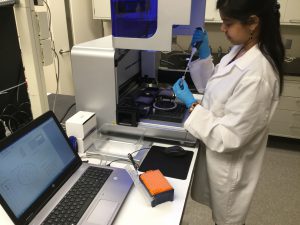 “This is a critical investment that advances the research mission of UT,” said Marcy McMahon, the chair of Women & Philanthropy. “We believe it will serve to improve public health and retain and attract talented scientists dedicated to curing diseases.”
“This is a critical investment that advances the research mission of UT,” said Marcy McMahon, the chair of Women & Philanthropy. “We believe it will serve to improve public health and retain and attract talented scientists dedicated to curing diseases.”
“The center truly transforms work in the emerging field of molecular diagnostics,” said Dr. David Kennedy, assistant professor in the Department of Medicine and co-director of the UT Women & Philanthropy Genetic Analysis Instrumentation Center. “By saving valuable time and using a high-quality process, it sets new standards for molecular testing and incorporates all workflow steps from sample preparation to genetic marker detection.”
“We are extremely grateful for the significant investment provided by Women & Philanthropy to establish the center, which will greatly enhance our capability to investigate numerous diseases and develop potential therapies,” said Dr. Steven Haller, assistant professor in the Department of Medicine and co-director of the new center with Kennedy.
The researchers recently received three grants totaling $450,000 from the Ohio Department of Higher Education to support their water quality research into how exposure to algal toxins, such as microcystin, affects organ function and to create new therapies to prevent and treat organ damage, especially in vulnerable patient populations.
“Although scientists in UT’s Department of Medicine are involved in many cutting-edge research projects vital to human health areas, they lacked the ability to process and examine multiple human and experimental samples for genetic analysis without significant delay,” McMahon said. “The Genetic Analysis Center meets that need.”
The UT Women & Philanthropy Genetic Analysis Instrumentation Center also received more than $45,000 in support from Qiagen, a biomedical company headquartered in Germany, to help pay for instruments, including:
- The Qiagen TissueLyser II, a tissue processor that allows up to 192 biological samples to be processed at the same time;
- The QIACube HT, a DNA-, RNA- and protein-extraction system that uses nucleic acid to quickly and easily purify DNA, RNA, protein and miRNA from almost any type of sample, including cells, tissues and food, as well as from bacteria and viruses in animal samples;
- The QIAgility, an automated liquid handling system that provides rapid, high-precision setup for polymerase chain reaction, a technique used to amplify, or make many copies of, a segment of DNA; and
- Real-time multiplex polymerase chain reaction thermal cyclers that use a centrifugal rotary design to allow each reaction tube to spin in a chamber of moving air, which keeps all samples at each step of the cycling program at exactly the same temperature. The system contains integrated Q-Rex software for data integration and analysis.
UT partners with Ohio’s public universities in efforts to close attainment gap
Monday, May 14th, 2018The University of Toledo is partnering with Ohio’s 13 other public universities to raise awareness of the value of public higher education and spur efforts to produce more college graduates to close the state’s higher education attainment gap.
The statewide campaign, called Forward Ohio, seeks to mobilize public support for enhanced investment in public higher education and ensure that it is a public policy imperative for state government.
“We know that higher education is a smart investment for the college graduate who will earn $1 million more than a high school graduate over the course of a lifetime,” UT President Sharon L. Gaber said. “It also is a smart investment for the state because Ohio needs a highly skilled workforce to attract and retain the jobs of the future. Public universities like The University of Toledo play an important role in training the majority of those skilled workers.”
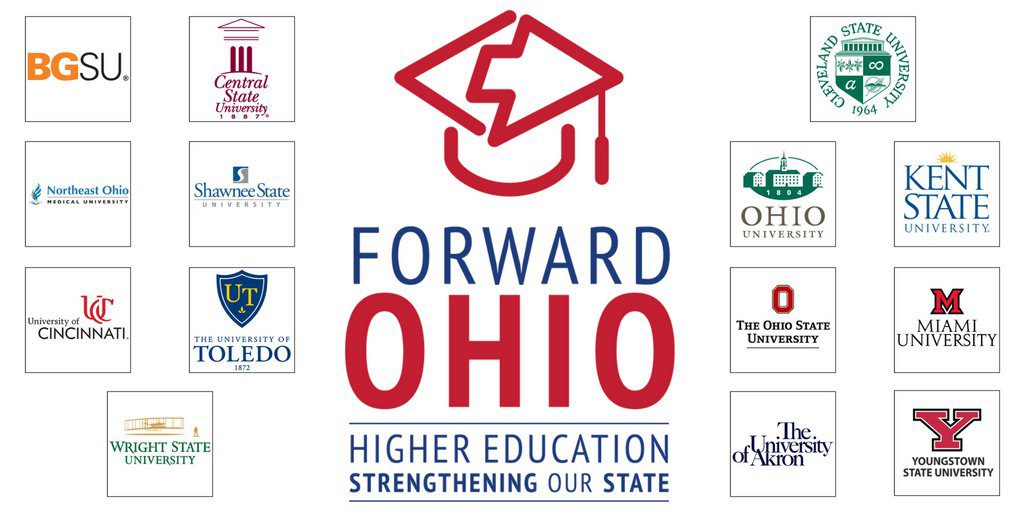
Studies indicate that about 66 percent of jobs in Ohio in 2025 will require degree, certificate or other postsecondary workforce credential. Currently, just 44 percent of working-age Ohioans have these credentials.
Currently, just 44 percent of working-age Ohioans have these credentials.The Forward Ohio campaign illustrates how maintaining a strong system of public higher education is essential to closing the attainment gap and meeting the economic and workforce needs of the state’s business community.
The Forward Ohio campaign illustrates how maintaining a strong system of public higher education is essential to closing the attainment gap and meeting the economic and workforce needs of the state’s business community.
In addition to producing the workforce of the future, public universities also have direct economic impacts on their communities. In northwest Ohio, UT is the region’s second-largest employer and has a $3.3 billion annual impact on the community. For every $1 invested by the state into UT, $10 of economic impact is generated to the local economy.
UT also is an exceptional value for our students providing a high-quality education with one of the lowest tuition rates among Ohio’s public universities.
The value of a UT degree has been validated by external sources such as Schools.com, which ranked UT Ohio’s best four-year college when analyzing criteria such as affordability, flexibility and student services. The website LendEDU also ranked UT the top Ohio public college for the lowest student debt. Most recently, Student Loan Hero listed Toledo third in its list of the 20 cheapest cities in the country for college students, a ranking based on cost-of-living data in college towns where students benefit from low room and board costs on and off campus.
“UT and all of Ohio’s public universities provide significant value to our students and to the state,” Gaber said. “I join my fellow university presidents in advocating for enhanced support for strong public higher education to move Ohio forward.”
Visit the Forward Ohio website at www.forwardohio.org for more detailed facts, figures and success stories.
Latino Youth Summit to educate, motivate prospective students
Monday, May 14th, 2018The University of Toledo will host the Latino Youth Summit from 9:15 a.m. to 1 p.m. Tuesday and Wednesday, May 15 and 16 for area high school and middle school students.
Junior high students will attend May 15, while high school students will visit May 16.
Each year, more than 500 Latino junior high and high school students visit campus to learn more about the different educational opportunities UT provides along with other postsecondary options.
A goal of the summit is to equip students and families with information and resources for college planning and different career paths that are available through sessions of pre-high school and pre-college course work.
“This is our 16th annual Latino Youth Summit,” said Aleiah Jones, program coordinator in the Office of Multicultural Student Success at UT and committee chair of the event. “It has a legacy in our community as being the largest gathering of Latino youth in northwest Ohio.”
The summit aims to encourage students to strive for success and a promising future while instilling a sense of pride for their heritage. It also seeks to address the Latino achievement gap in northwest Ohio, according to Jones.
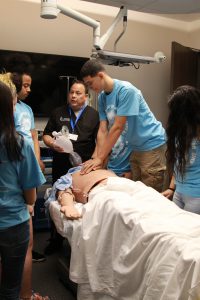 During this event, students will participate in hands-on activities in different fields such as pharmacy, nursing and engineering, and learn about educational opportunities both at UT and abroad.
During this event, students will participate in hands-on activities in different fields such as pharmacy, nursing and engineering, and learn about educational opportunities both at UT and abroad.
High school students who register and attend the event are encouraged to apply for the President’s Summit Award worth $2,000 annually. Ten of these scholarships are available and will include room and board for each recipient’s first year.
This year’s keynote speaker is Josué “JQ” Quiñones, an educator and life coach. His address is 10 a.m. in the Thompson Student Union Auditorium on both days of the summit.
Quiñones was born and raised in the Hunts Point area of the South Bronx in New York. He will share his story about attending college to create a better life for himself. He is dedicated to inspiring and providing motivation to audiences along with encouraging them to live a “quality lifestyle built for success” and has spoken to more than 20,000 students and professionals.
“As he frequently shares, his life experience has led him to truly believe what you actively and consistently engage in, or surround yourself with, is a determining factor of success,” Jones said.
This ideology and lifestyle led Quiñones to coin the phrase: “Success is a lifestyle!”

